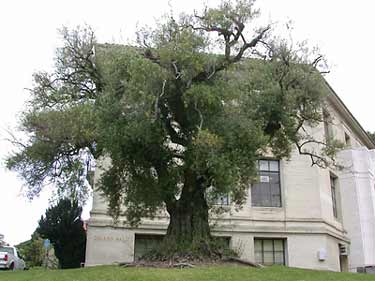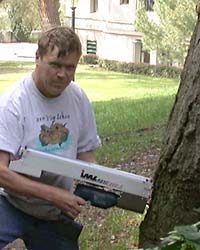 |
Olive (Olea europa) at Giannini Hall. This tree was planted in the late 1800's where Giannini Hall now stands, and was later moved to this location. |
UC Berkeley arborist launches new Tree Fund to encourage campus planting
BERKELEY – The lofty trees and lush greenery of the University of California, Berkeley, campus make a lasting impression on visitors and students alike, but what people don't see are the many empty niches left by trees that have died and not been replaced.
Now, a campus arborist has launched the Tree Fund, a grass-roots campaign to raise money to buy and plant trees to replace those lost to disease, and to take more intensive care of the campus's oldest and most cherished trees.
 Campus Arborist Richard Trout uses a Resistograph to determine the extent of decay in an oak. |
Ever since he was hired as chief arborist in 2000, Richard Trout has lamented the stagnant $1,000-per-year campus budget for plant replacement, a legacy of the state's last budget crisis in the early 1990s. With even worse budget cuts in store for the future, he sees no choice but to ask tree lovers for money to replant and make sure the heritage trees of the Berkeley campus don't disappear.
"The trees are an important part of what people remember long after they have left UC Berkeley," said Trout, now campus coordinator for sudden oak death, a disease threatening bay laurels, redwoods and oaks on the campus. "Berkeley is a beautiful site because we have the most interesting and certainly the oldest planted trees of any UC campus. Without the trees, we'd be just an urban commuter college."
The oldest planted trees on campus are redwoods in the center of campus, southeast of Giannini Hall, planted by the original owners of the property more than 140 years ago. Some of the oaks and bays probably predate the establishment of the campus.
Trout points to other treasures as well, in particular the unique specimen trees: the unusual titoki tree of New Zealand, planted along West Crescent some 125 years ago; the many olive trees around Giannini and Wellman Halls, transplanted there from the university's original botanical garden; and the bizarre buckeye tree near Faculty Glade, its insides rotted out but thriving nonetheless.
But, Trout estimates, some 30 UC Berkeley trees die and are removed every year, victims of disease such as root rot or butt rot, insect pests or plain old age. With more than 2,000 individual trees on campus representing 200-plus species, this may not be noticed by the casual visitor, but long-time residents can't but note the passing of major landscape trees: two gnarled coast live oaks removed last year from the glade outside the Faculty Club; the rotted-out Monterey cypress cut down earlier this year next to McCone Hall; or the soaring eucalyptus, 4 feet in diameter, that had to be removed five years ago from the backyard of University House, the chancellor's residence, before it toppled.
With a single 12-foot tree costing up to $800, the budget for plant materials - grass and bushes as well as trees - doesn't go far. Additional money is often found to replace prominent landscape trees like the Faculty Glade oak, but less noticeable sites remain empty, sometimes for decades.
Who remembers, for example, the lane of 11 pepper trees, only three of which now remain, that once bordered the music building, Morrison Hall? Or the five Port Orford cedars along Strawberry Creek north of the Valley Life Sciences Building that today have been reduced to one.
In recent years, four to five mature coast live oaks, the species native to the site on which the campus was established 135 years ago, have died along the north fork of Strawberry Creek. And the campus's last turkey oak, a tall European specimen, died recently - a victim of oak root fungus - near the west entrance to campus.
On the website Trout created to raise money and highlight the campus's trees (http://landscape.ced.berkeley.edu/~treefund/), he has a special page devoted to stately trees that have recently died. He's dubbed it "Rest in Pieces."
"The fund would help replace the trees that fail in the landscape, bringing in long-lived trees like oaks but also short-lived ornamentals like pears and flowering cherries," he said. "We could easily plant 100 trees per year or more for a number of years because of the built-up deficit."
Trout's supervisor, operations manager Phil Cody, is excited about the fund-raising campaign.
"Trees are the backbone of any landscape, and it's a shame that we haven't been able to fund the planting of new trees to replace ones that died or had to be removed," said Cody, who oversees a three-man tree crew in the campus's grounds unit. "It takes a long time for them to grow, and I consider it important to get them in quickly to establish themselves."
An important first step in assessing the status of campus trees is an inventory that is now underway thanks to John Radke, associate professor of landscape architecture. Last year, students in his annual fall class on computer applications in landscape architecture began an inventory and mapping of all trees on the 178-acre core campus. About half the project is complete, and students will resume work on it in the fall.
"There have been major changes since the last inventory of campus trees in 1976," said Trout, who received his BA in anthropology and Native American Studies, his master's degree in environmental planning from UC Berkeley, and took a course from Radke. "For example, we've lost more than 20 percent of the campus's live oaks, which is something you wouldn't know without an inventory like this."
Trout expects about two-thirds of any money raised to go toward tree replacement, with the remainder to be used to purchase equipment to monitor or maintain the health of current trees.
"Along with its many beautiful and memorable specimens, the campus has an aging tree population, with many in decline," noted Trout. "The Tree Fund will provide diagnostic tools to evaluate tree health and hazard, and also pay for special equipment."
These include sonic tomography equipment to check the inner health of trees without invasive drilling, and a compressed-air excavator to dig around roots without damaging them.
"One of the major problems on such an old campus is soil compaction, which cuts off air to the roots," Trout said. Many trees would benefit from radial trenching - that is, removal of soil to a depth of 12-18 inches in radial spokes outward from the trunk - and replacement with new, more porous soil. Even the eucalyptus grove, a group of blue gums planted in 1877 and containing the tallest eucalyptus trees in California, would benefit from soil aeration.
"With an air excavator, we can go in and clear out the soil in a fifth the time it takes with hand tools," Cody said, though, for now, the $24,000 compressor is on his wish list. "That would free up the tree crew to do other tree maintenance work."
One of the crew's long-term projects is the removal of grass and irrigation from around the trunks of oaks and other trees to improve their health and prevent root rot.
In discussing the Tree Fund, Trout and Cody wrestled with the issue of how to thank donors. Plaques on trees are out of the question, but one option is for donors to adopt a tree.
"I think this fund will evolve," Cody said, adding that the ideal would be a long-term tree replacement plan that donors could follow as it progresses. "It would be nice if people could actually walk up to a place and say, 'I contributed to that.'"
Trout has trees in his blood. His mother's father - a Swede working as a gardener in Germany - emigrated to the United States after seeing pictures of the giant sequoias in Yosemite National Park. He got a job as a gardener in Fresno, planting many of the trees in the city's main park, and ran a nursery in Sequoia National Park in the 1930s to supply native plant seedlings for landscaping The General's Highway that was being built between Sequoia and King's Canyon National Parks. His grandparents later ran a nursery in Long Beach. On his father's side, an uncle was manager of the University of Michigan botanical gardens in Ann Arbor.
The vision Trout has for the campus's future includes trees as old as those today in some of England's great parks - 400- to 500-year-old oaks and ginkgos, gnarled and lichen-covered pines.
"We could have trees that old if we take care of them," he said. "We already go to extra lengths to keep the 100-year-old trees healthy."
Trout wears his sentiments at the bottom of every e-mail message, where he quotes John F. Kennedy's remark during his Charter Day speech at UC Berkeley's Greek Theatre on March 23, 1962: "The great French Marshall Lyautey once asked his gardener to plant a tree. The gardener objected that the tree was slow growing and would not reach maturity for 100 years. The Marshall replied, 'In that case, there is no time to lose; plant it this afternoon!'"

